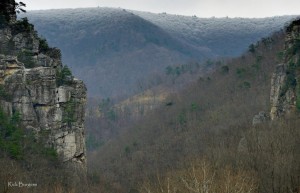
Seneca Rocks provides rock climbers in the eastern U.S. the unique opportunity to experience a taste of alpine climbing, through which the uninitiated can experience some of the challenges of climbing an entire mountain.
The approach begins with a 15-minute hike from the car or campsite to the base of the mountain, after which the trail ascends a few hundred feet of unrelenting, knee-high, man-made steps affectionately known as the "stairmaster." The base of many routes that ascend the summits of Seneca may then be gained through some third-class scrambling before it’s time to tie in.
The climbing is very traditional. All gear is placed by the leader, with the exception of occasional rusty pitons left behind from Army training in the early 1940s. (Despite being decades old, you’re often grateful to clip onto them.)
The most adventurous routes ascend above the tops of trees, where even the most seasoned mountain climber is likely to feel extremely exposed and will experience the unmistakable feeling of being out there with nothing but air beneath and the valley dropping away hundreds of feet below.
The geometry of the rock at Seneca has created many vertical and horizontal cracks and by a range of detached blocks that vary in size from that of a toaster to a refrigerator. Gear protection is good, though it can be difficult to find solid placements that don't utilize cracks made by detached blocks. For this reason, many climbers prefer passive protection.
Seneca offers climbers the chance to experience of a true technical summit. It's southern summit is among the most singular found anywhere -- a knife-edge ridge less than 10 feet wide in spots, with a valley dropping away 1,000 feet below. The descents are not to be taken lightly and often involve down-climbing and a series of long rappels from multiple sets of trees or fixed anchors.
Seneca Rocks is an impressive representation of the nearly white, fine grained Tuscarora Quartzite, very similar to the rock found in the Shawangunks, or the Gunks, of New York, where the rocks at Seneca exhibit less horizontal bedding. Seneca’s appearance is the result of geologic forces at work during the formation of the Appalachian Mountains that folded these layers and turned them on end. The less resistant surrounding rocks were since eroded, leaving behind the enormous sheer fins of Tuscarora Quartzite.
Viewed from the town of Seneca Rocks, the formation presents the western face of the north-south oriented ridge. From here it resembles a huge fin with two peaks separated by a saddle called The Gunsight. Many climbing routes ascend the the northern summit, which is also accessible by hiking trail. The southern summit is accessible only by climbing, and it has been referred to as one of the highest summits in the east that is accessible only by technical climbing.
Little is known about the climbing history of this area before the turn of the 20th century. It is possible that ascents were made by Native Americans or European settlers, but we can only speculate. The recorded climbing history dates back to 1908, when the first ascent of the South Peak was made, the proof being a carved inscription thereon that remains barely visible today. Ascents made prior to World War II were limited to a small group of adventurous climbers who tied hemp ropes around their waists.
During World War II, Seneca Rocks was used as a training ground for the U.S. Army’s 10th Mountain Division. During this training,the troops learned technical mountain skills and hammered tens of thousands of pitons into the rock. Many of these are still in place.
After the war, these pitons and army surplus such as carabiners and nylon rope became readily available and led to advances in the sport. With their primitive gear and hiking boots, climbers at Seneca continued to climb routes of increasing difficulty. Long before the days of rappel-bolted sport climbs, this golden age of climbing produced an ethic that valued ground-up ascents. Climbers had little or no reference for rating climbs. As the modern Yosemite Decimal System was not developed until the early 1950s, these early climbs were rated later by the next generation of climbers. Many routes were established before the scale had adapted to its current range, and this may partly explain why some climbers feel the ratings at Seneca are difficult for the grade.
The divergent value of ratings, combined with the mental challenge of high exposure and less-than-excellent friction of fine-grained quartzite, has lead to an invariably exciting experience. It’s interesting to note that the pioneer climbers at Seneca ascended these routes without modern harnesses, spring-loaded camming devices, or sticky rubber climbing shoes.
Many challenges and hazards are to be encountered at Seneca Rocks. Extreme sun exposure and the high reflectivity of the quartzite demand demand that climbers pack sufficient sun protection, including sunscreen and sunglasses. Seneca is notorious for occasional loose rocks -- both on route and on belay ledges -- so helmets and sufficient caution are highly recommended. As Seneca is such a popular multi-pitch climbing destination, these hazards are increased by climbing beneath other parties, who may often be novice, due to the abundance of moderate climbs.
Frequent high winds can lead to communication problems between climbers, particularly near the exposed summits. Other hazards include route-finding difficulties, occasional sparse protection, poor fixed protection, and steep and exposed scrambling on approaches and summits. Technical descents often require multiple rappels to reach the ground; always tie knots in the ends of ropes to avoid rappel disasters. Rescue is complicated by the remote setting and the steep technical nature of approaches.
Read also: Seneca Rocks Climbing Area
David Wolff is a certified climbing instructor and climbing guide at the New River Climbing School in southern West Virginia






























